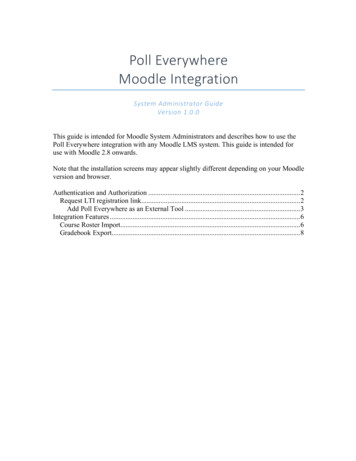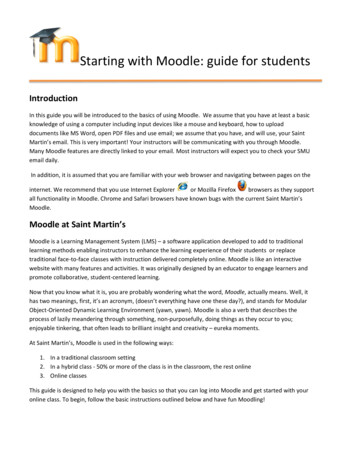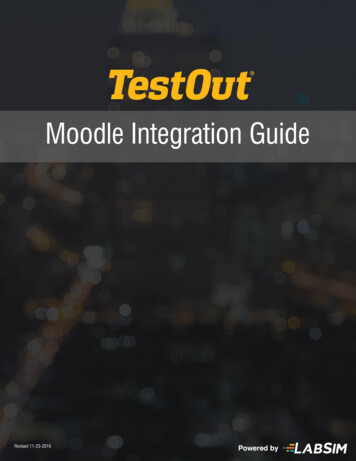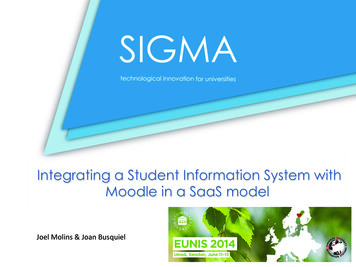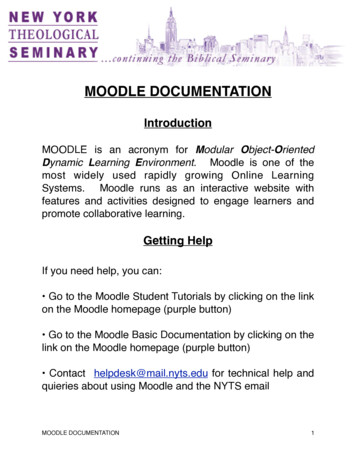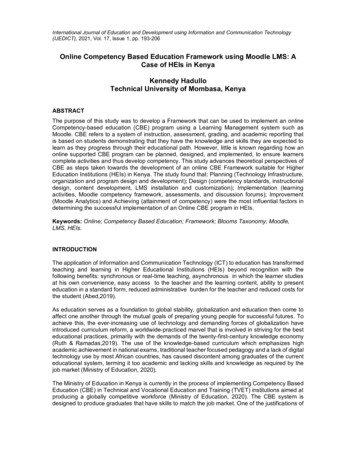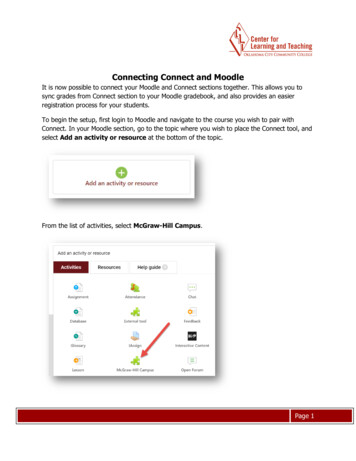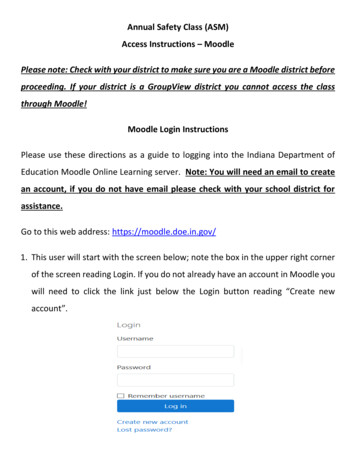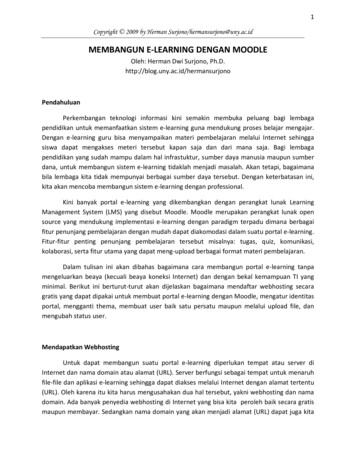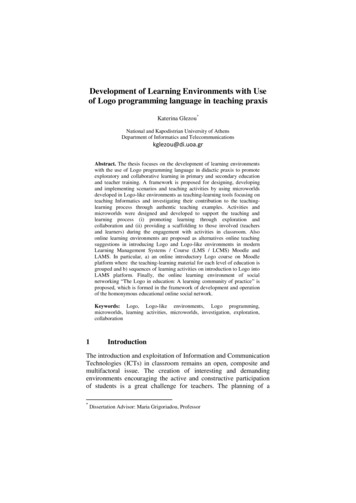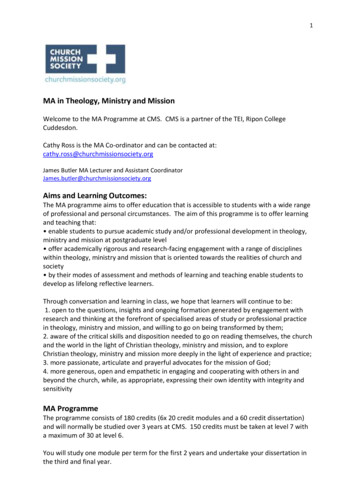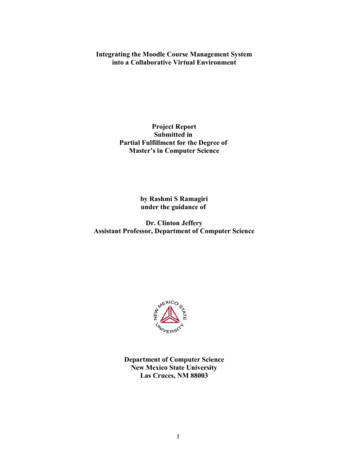
Transcription
Integrating the Moodle Course Management Systeminto a Collaborative Virtual EnvironmentProject ReportSubmitted inPartial Fulfillment for the Degree ofMaster’s in Computer Scienceby Rashmi S Ramagiriunder the guidance ofDr. Clinton JefferyAssistant Professor, Department of Computer ScienceDepartment of Computer ScienceNew Mexico State UniversityLas Cruces, NM 880031
Table of ContentsAbstract1. Introduction2. Unicon ODBC3. Moodle3.1 Moodle Modules3.2 Working with the Moodle Interface3.3 Installing Moodle on Linux3.4 Configuring unixODBC4. Requirements4.1. Functional Requirements4.2. Non-functional Requirements5. Design6. Implementation6.1. Moodle.icn6.2. nshworld.icn6.3. CourseTabItem.icn6.4. nshdlg.icn7. Graphical Outputs8. Related work9. Conclusions and Future work10. References2
AbstractA virtual environment that acts as a user interface to provide communication between humanhuman in addition to human-machine is called Collaborative Virtual Environment. An EducationalVirtual Environment is a collection of integrated tools enabling online learning by providing adelivery mechanism which involves tracking of student activity along with access to resourcesvirtually. Educational CVEs are a technological breakthrough with the potential to provide students,teachers and learners a platform for discussion and sharing of views. CVEs have tremendouspotential to enhance the learning environments of the future; they provide a real time environmentfor users to interact when they are physically in two different geographical locations. Theinstructors can operate courses remotely and the students can access the course materials throughthe Collaborative Virtual Environment. This project is an attempt to provideeducational/courseware support for instructors and students in the Collaborative VirtualEnvironment. The design includes the integration of features of Moodle (Modular Object-OrientedDynamic Learning Environment), a free, open source course management system for onlinelearning. This involves integration of a MySql relational database which allows courseware supportto the Virtual Environment called unicron. This project is written in the Unicon language whichmanipulates SQL databases through the Open DataBase Connectivity connection mechanism.3
1. IntroductionVirtual Reality (VR) sprang onto the public stage in the 1980’s due to media interest and relatedworks of science fiction. VR promised to change the way people experience and interact withcomputers. One of the major fields in VR is Collaborative Virtual Environments (CVEs). The maingoal of CVEs is to develop better and more effective ways to use computers for communication[Churchill].With the advent of online learning through the Internet, a new breed of educational environment hasemerged rapidly, wherein individuals can share information through remote interaction with eachother. Students can collaborate to learn, solve problems and be highly productive and efficient. ACollaborative Virtual Environment is a computer-based, distributed, virtual space where people canmeet and interact with others. Collaborative Virtual Environments can be used productively in thefield of education, as a potential technology to facilitate more active student and instructorcollaboration and learning. Collaborative Virtual Environments help to provide distance educationand are effective substitutes for bonding people and for in-person social necessities. CollaborativeVirtual Environments are of particular interest to researchers and students in areas related tocomputer supported cooperative and collaborative work and human computer interaction. Theyallow the instructor to teach courses at their own technological comfort level by providingtemplates for course management.Though existing tool such as Centra, provides whiteboard, handraising, webpages sharing/cobrowsing. It does not offer the advantages of educational CVE which include nearness and socialpresence through a shared virtual space populated by avatars. A student should get the real classroom experience even while accessing the courses remotely [Jeffery05]. A research team at NMSUhas developed Unicron, a Collaborative Virtual Environment for the purpose of computer sciencedistance education that brings a class room experience to students in remote locations. Unicron hasbeen modeled after the first floor of Science Hall at NMSU. Unicron will provide distanceeducation which will supersede the traditional video-conferencing and use of educational tools suchas WebCT by integrating these existing educational technologies into the 3D virtual community.This report presents the design and implementation of the courseware support in a collaborativevirtual environment allowing remote student-instructor interactions. This is achieved by integratingthe features of open-source course management software called Moodle that supports a socialconstructionist framework of education and allows educators to create an effective, productiveonline learning environment, hence making online learning more.The project was developed on Linux (2.6.11.4-21.9-SMP) running on a Pentium 4 processorrunning at 3 Giga hertz with HyperThreading. The memory of the system was 512MB. The versionof the unicon compiler used to build the project was unicon version 11.3(beta). The project requireda few other packages, they are mysql-4.1.10a-3 andunixODBC-2.2.10-3.4
2. Unicon ODBCThe term Unicon stems from Icon [Jeffery03]. Unicon is platform-independent, portable, robustlanguage and is well-suited in developing object oriented applications, network centric applications,and database programming.Database Architectures and ODBCUnicon supports databases such as DBM and MySQL. A connectivity mechanism is needed inorder to communicate with databases such as MySQL etc. The ODBC interface serves this purpose.Unicon’s SQL tools require numerous software components. Firstly, a SQL server is required forODBC connectivity, along with a generic account with suitable privileges on the SQL server isrequired for connectivity. Lastly the ODBC driver manager and an ODBC driver configured to suitthe database requirements are needed on the clients. The next task is to code the Unicon client inorder to connect to the database [Balbi02].Opening a SQL DatabaseA sql database can be opened by an open () function is used to open a connection to a SQLdatabase. For the integration of moodle into unicron, the database operations were performed onmoodle database. For more information about unicon ODBC, please refer to [Balbi02].An example of the open () function that connects to the database is shown below.C: open (“cve”, "o","moodle", "username", "password")Querying and Modifying a SQL DatabaseThe sql() function is used to perform queries on the database[Balbi02]. The two arguments are thedatabase and a sql command such as a select, update, modify etc. The sql function places the cursorat the beginning row of the selected result set.One example of the sql function is.sql (C, "select firstname from person where firstname like ‘Andr %'")The second argument in the above sql call returns rows that match the criteria of all names startingwith Andr.Navigating across the selected rows in a tableThe fetch() function is called in order to navigate across the resultset (the returned rows). Thefetch() function takes the database name as its argument. The return value of this function is asingle row in a table.If a fetch (C) returns a row containing column firstname, one can writerow: fetch (C)write (row.firstname)When the fetch function has one argument, fetch (C) moves the cursor forward one position.When passed with two arguments, the database name and the column, fetch (C, firstname) returns asingle column from the current row.5
SQL Types and Unicon TypesSome of the data types supported by SQL and Unicon are CHAR and VARCHAR that correspondto Icon strings, INTEGER and SMALLINT data types that correspond to integers, FLOAT andREAL that correspond to reals etc. The conversion between SQL and Icon is fairly easy and withminimal changes to the data format. One needs to understand the pros and cons related to SQL im plementations.3. MoodleMoodle is an open source web-based course management system designed based on the principlesof social pedagogy. Moodle produces Internet-based courses and websites; it requires a web serverwith integrated PHP (which is the scripting language) and database support [moodle].Moodle supplements the traditional face-to-face learning by providing online-classes, is userfriendly, simple, efficient, compatible, easy to install on any platform that supports PHP. It requiresan underlying Sql database.The entire moodle system is managed by an admin user during setup. The administrator is permittedto customize the site colors, fonts, layout etc to suit his needs. The Moodle is then added with therequired activity modules. The source code is easy to modify to suit the student’s needs.3.1 Moodle ModulesThis section discusses the different modules supported by moodle.3.1.1 Site ManagementThis module is used for site management used for web interface which has no importance forunicron. This application incorporates authentication mechanisms using plug-in modules, whichallows the legacy systems to be easily integrated. The standard email mechanism enables studentsto create their own login accounts which are verifiable by confirmation. The LDAP mechanismfacilitates login accounts to be checked against an LDAP server. The administrator can specifywhich fields to use. Typically the IMAP, POP3 and NNTP are checked against mail or news serverand security provisions such as SSL certificates and TLS are supported as well. This applicationalso supports external authentication wherein any database with at least two fields can serve as anexternal authentication source.3.1.2 User Account ManagementThough this module is important for user account management, its not been incorporated in unicronyet, all the user account management is done through the web interface provided by moodle.Different sets of accounts can be created on the server. The admin account has administrativeprivileges and controls course creation and user accounts. Every individual has one accountassigned for the entire server; however access privileges may vary for these accounts. A coursecreator account can be assigned privileges to create courses and teachers typically have editingprivileges which can be revoked to prevent course modification. Teachers can also enroll andunenroll students manually. This process can however be automated. Security is incorporatedthrough key mechanism such as enrollment key to prevent non-students from accessing the coursepage. Time-zone data and language information can also be accessed by the user.6
3.1.3 Course ManagementA full teacher has admin privileges to restrict other teachers and also to control the over-all settingsfor a course. The teacher can set the course formats by week, by topic or by social format. An arrayof course activities such as Quizzes, Forums, resources, assignments, etc can be developed. Thecourse catalog homepage could be used to display any changes to the courses. The webpage canalso be used to post grades for quizzes and assignments. These web pages can be edited using aweb-based programming editor such as an HTML editor. Activity reports can also be generated forlogging and tracking access information. Graphs and visual information can be embedded in thesereports.3.1.4 Assignment moduleThis module has been completed integrated into the unicron. It is used to post assignments with duedates wherein students can upload their assignments. It also provides a provision to timestampstudent submissions and to display grades.3.1.5 Chat moduleThis module has already been integrated in unicron in the form of text-based communication. It isunlikely that, this module will be integrated in the future. But the logging information is used to thefull extent by logging in all the chat information for archiving purpose.3.1.6 Choice ModuleThe Choice Module uses the principle of polls to obtain student feedback through votes. It alsosupports graphical data. This module has not been integrated into unicron.3.1.7 Forum ModuleThis module has been partially integrated. It enables discussions relevant to teachers, courses andstudents. Discussions can be single or multi-threaded. The module also supports images and alsoallows discussion threads to be moved from one forum to another.3.1.8 Quiz ModuleThe quiz module relies on a database of questions to generate a quiz for every student. Questionscan be sequential or random. The module allows quizzes to be created automatically and insertingthe time-frame for each quiz. At the teacher’s discretion, quizzes can be set for students to attendmultiple times and can also include images, true or false questions, short- answer questions,embedded answer questions, etc.3.1.9 Resource ModuleThis module has been partially integrated, only text information are displayed. The module supportsinteractive content such as video, sounds, PowerPoint, flash, etc. It can also be seamlessly linkedwith external applications.3.1.10 Survey ModuleThe survey module supports built-in surveys with graphs and spreadsheets that can be posted on aweb-page. The module also provides feedbacks to students once completed. This module is notintegrated into the unicron.7
3.1.11 Workshop ModuleThis module serves as an assessment tool wherein peers can assess documents and teachers cangrade their assessed documents. It supports a wide range of grading scales such as the likart scale.This module is not integrated into the unicron.3.2 Working with the Moodle InterfaceThis section deals with adding a course from the instructor’s point of view and course navigationfrom the student’s side using the moodle web interface.3.2.1 Adding a course in Moodle- Teacher’s GuideTeachers can create online courses with moodle. The teacher logs in via the web with the teacheraccount assigned by the administrator. Under the administration icon on the course home page, theoption setting allows the teacher to change the course settings ranging from its name to what day itstarts.Under the settings option the course format will help the teacher to use the basic layout of thecourse like a template. Moodle supports three formats: weekly format, topics format and socialformat. Weekly format covers lectures exactly for one week whereas the topic format covers anytopic the teacher likes. The social format is based around just one forum which is displayed on themain page and does not use much content.Moodle also supports uploading all kinds of files such as web pages, audio files, video files, worddocuments, etc. This can be done through the Files link under the administration icon. All theuploaded files are stored on the server and these files can be moved, renamed, deleted or edited.These files are accessible to the teachers alone and are made available to the students later. The filesare organized into sub-directories for easy and convenient accessibility. In the current moodle, onlyone file can be uploaded at a time through the web interface. In order to upload more than one file,a zip program can be used to compress and group the files into an archive file which can then beuploaded.In the main course page, the teacher can add all the course activity modules in the order thatstudents will access them. The standard course activities included are assignment, choice, forum,resource, quiz and survey. In order to add a new activity the teacher has to go into one of the formatsections explained above and select the type of activity from the pop-up menu.3.2.2 Course Navigation- Student’s GuideThe student has to first access the course website using the site address provided by the teacher. Ifthe student is accessing the course website for the first time, he has to start by first creating a newaccount. The new account created will give the student access to all the courses. Individual coursesmay require a once only enrollment key to access them.The procedure to create a new account starts with the student clicking on “Start now by creating anew account” button in www.moodle.org page followed by filling out the new account form andcreating a username and password. A confirmation email containing a web link will be sent to theemail address provided by the student. The student account will be confirmed once the studentclicks on the web link provided in the email. He can now see all the available courses and can selectthe course that he wants to enroll. When a student tries to enroll into a course for the first time, he8
will be prompted for the enrollment key which will later be used by this student to enter therespective courses.Once the student enters the course he can navigate through the various pages using the courseactivity modules.3.3 Installing Moodle on LinuxMoodle is primarily developed in Linux using Apache, MySQL and PHP [moodle]. It requires1. Web server software. It works under any web server that supports PHP, such as IIS onWindows platforms.2. PHP scripting language (version 4.1.0 or later).3. a working database server such as MySQLMoodle can be installed by downloading and copying the files into the main web server documentsdirectory. The install script is then run to create config.php which can be done by accessing theMoodle main URL using a web browser or by accessing http://yourserver/install.php directly. Theweb server is set up to use index.php as a default page. This is done by using a DirectoryIndexparameter in the httpd.conf file in Apache. Moodle requires a number of PHP settings to be activein order for it to work. On most servers these will already be the default settings.Creating a database called moodleAn empty database is created in the database system along with a special user that has access to thedatabase and is granted administrative privileges.Some examples for Unix command lines for MySQL are:# mysql -u root -p CREATE DATABASE moodle; GRANT SELECT, INSERT, UPDATE, DELETE, CREATE, DROP, INDEX, ALTER ONmoodle.*TO moodleuser@localhost IDENTIFIED BY 'yourpassword'; quitCreating a data directory called moodledataA data directory is created by the moodle installer that needs some space on the server’s hard diskto store uploaded files such as documents and user pictures. This can be done manually if it fails.ConfigurationWhen the admin page is accessed for the first time, a GPL agreement is provided that must beagreed upon by the user to continue with the setup. Moodle will then set up the database and createtables to store data, followed by a number of SQL statements and status messages. It then allowsthe users to define the parameters for the Moodle site. The final step is to create top-leveladministration user to the admin pages. The admin then can perform tasks such as creation anddeletion of courses, creation and editing of user accounts (student and teacher accounts), etc.9
Set up cronMoodle modules sometimes require continual checks to perform tasks. The admin directorycontains a script called cron.php that does the continual checks. These checks cannot run bythemselves and need a setup mechanism wherein the script is run at regular intervals. This setupmechanism is known as the cron service.Using the crontab program on UnixAll that Cpanel does is provide a web interface to a Unix utility known as crontab.Type the following in the command linecrontab -eand then add one of the below commands using any editor tool:*/5 * * * * wget -q -O /dev/null http://example.com/moodle/admin/cron.php3.4 Configuring unixODBCThe following section helps in configuring unixODBC on the client side.Fetching ODBC driverThe unixODBC source distribution is available at www.unixodbc.org, a gzipped tar file which isuncompressed using the gunzip command and then the resultant file is untarred using the unix tar(tape archive retrieval) [Easysoft].For examplegunzip unixODBC-2.2.12.tar.gztar -xvf unixODBC-2.2.12.tarChange into the resultant directory and run:. /configure --helpInstalling ODBC driverInstalling ODBC driver can be done three different ways. First Method is by writing a programwhich links with libodbcinst.so and calls SQLInstallDriver. Second Method is by creating anODBC driver template file and running odbcinst. For example, odbcinst -ftemplate file -d –I, where the template file must contain the Driver and Descriptionattributes. Third method is by editing the odbcinst.ini file and adding the driver definition. Eachdriver definition in the odbcinst.ini begins with the driver name in square brackets which isfollowed by Driver and Setup attributes. Driver is the path to the ODBC driver shared object andSetup is the path to the ODBC driver setup libraryIn unixODBC ODBC drivers are defined in the odbcinst.ini file.File DSN'sODBC has a file DSN that stores the connection information in a file saved on to a central serverthat is accessible to all the workstations.Configuring a MyODBC DSN on *nix.odbcinst.iniThis contains a section heading that provides a name for the driver. The Driver and Setup pathspoint to the ODBC driver and setup libs.10
The template for odbcinst.ini is:[MySQL]Description ODBC Driver for MySQLDriver /usr/lib/unixODBC/libmyodbc3.soSetup /usr/lib/unixODBC/libodbcmyS.soFileUsage 1CPTimeout CPReuse UsageCount 2[.]odbc.iniThe contents of the odbc.ini files follow just the same format as the odbcinst.ini entries.The template for odbc.ini is:[mydsn]Description MySQL database moodleDriver MySQLSERVER cve.cs.nmsu.eduDATABASE moodlePORT 3306Socket Option Stmt USER username in mysql password password for the above user in mysql Trace 1TraceFile error.logThe template for odbc.ini in /etc/unixODBC/odbc.ini is:[mydsn]Description MySQL database moodleDriver MySQLServer cve.cs.nmsu.eduDatabase moodlePort 3306Socket Option Stmt USER username in mysql password password for the above user in mysql ParameterDefault ValueCommentServerLocalhostThe hostname of the MySQL server.DatabaseThe default database.11
Option0Options that specify how MyODBCshould work. See below.Port3306The TCP/IP port to use if server is notlocalhost.StmtPasswordSocketA statement to execute when connectingto MySQL.The password for the user account onserver.The Unix socket file or Windows namedpipe to connect to if server is localhostEstablishing a Remote Connection to Server from System AServer side: Start the MySQL server. Use grant to set up an account with a username and a password of the user who canconnect from system BGRANT ALL ON *.* to 'myuser'@'A' IDENTIFIED BY 'mypassword'; The GRANT statement grants all privileges to user myuser for connecting fromsystem A using the password mypassword. To execute this statement, root privilegesare required on system A.System A side:Configure a MyODBC DSN using the following connection parameters: DSN remote test SERVER or HOST A (or IP address of system A) DATABASE test USER myuser PASSWORD mypassword.4. RequirementsThis section discusses about the functional requirements and the non-functional requirements.Certain features are taken from moodle design and integrated into unicron which allows integrationof courseware support to the CVE. These features include addition of assignment submission,display of lecture notes and assignment description posted for a particular course. Also display theforums or posts posted to a particular course in the unicron. Chat module from moodle is notintegrated into unicron, since it is already a part of unicron mode of communication. To keep trackof student’s activity, all the client information is logged including chat information.4.1. Functional RequirementsView Students informationUser: StudentDescription: View list of courses enrolled by the user. The following details will be visible12
Individual NameThe course listThe instructor’s name for the courseThe instructor’s email address for the courseDependencies/Constraints: None View Courses EnrolledUser: StudentDescription: A list of all possible courses the student is enrolled. The following details will also bevisible The course Name The Lectures posted for the course The assignments posted for that course All the postings for the courseDependencies/Constraints: NoneView Assignments for a courseUser: StudentDescription: A list of all the assignments posted for a course. The following details will also be visi ble The name of the assignment Complete information of the assignment Due date for the assignment The time of posting of the assignment The time of last submission by the user A dialogue box for uploading the assignmentDependencies/Constraints: If the due date for the assignment is over, no submission is possible forthat particular assignment. The dialogue box for uploading the assignment will not be shown to theuser.Select Lecture TopicUser: StudentDescription: Students may select topic from a dropdown list Complete information of the Lecture notes selected by the userDependencies/Constraints: None4.2 Non-Functional RequirementsThis section includes the hardware and software constraints.4.2.1 Hardware Constraints and specificationThe hardware constraints and specifications on the server side include a minimum hardware supportto host Unicron and Moodle. On the user side, any computer system that can run Unicron and a net work connection, in case the unicron server or moodle database are hosted remotely4.2.2 Software Requirements13
To run unicron on the server side, the system should include unicron server and a mysql databaseserver. The unicron server and mysql database server need not be on the same machine. This projectwas tested on Linux platform, and is recommended to run on Linux platform, till further testing isdone on other platforms like Windows, or any other operating system that Unicron supports.On the Client side, Linux operating system is recommended with unicron client installed on it.Client side should contain MyODBC-unixODBC package for Unicron-moodle communication.5. DesignThe main goal of this project is to integrate the features of moodle into unicron. This is achieved byproviding a thin layer between Sql and the cve. The connection between the cve and the database iscreated in the class moodle. To provide course management the above connection helps inexecuting the sql operations between the cve and the database. The course management is mainlyfocused in displaying the lecture information, assignment description, assignment submission,logging chat information and user activity. The implementation details of the above mentioned classis discussed in the later section.When a user logs in, apart from creating a virtual environment, a connection is made to the MySQLdatabase from the client side to retrieve the courses the user is enrolled to. The CVE displays thecourse information like the assignments, lecture notes and posting. The user can also submit theassignments from the Virtual Environment.In order to achieve the goal of this project, the design should involve developing a unified, intuitiveand single application that would make use of collaborative virtual environment features andmoodle. The developed interface should be clearly organized and easy to navigate. To provide thiskind of interface, a new sub window is added along with the virtual environment, which wouldrepresent the courses that the user enrolled into.To display the course information a new tab is created at runtime by the class CourseTabItem. Thisclass is called from the nshdialog class which deals with the user interface.TabItemDialogThe below figure is a .UML diagram showing the inheritance of the .classes used in this project. . .NSHDialogCourseTabItem . . . .World . .Moodle .14 .
Figure 1: UML DiagramMoodle Database Structure Every table has an auto-incrementing id field (INT10) as primary index. The main table containing instances of each module has the same name as the module. Following are the minimum fields contained in the main table:id - as described abovecourse - the id of the course that each instance belongs toname - the full name of each instance of the module Other associated tables with a module that contain information are named as school info(example, mdl user students) Simple and short column names are used. Columns that contain a reference to the id field of another table (eg widget) are called aswidgetid. Boolean fields are implemented as small integer fields (eg INT4). Most tables have a time modified field (INT10) which is updated with a currenttimestamp obtained with the PHP time () function.There are 132 tables in the moodle database. The main twelve tables are mdl config,mdl course,mdl course categories,mdl course modules,mdl course sections,mdl log,mdl log display,mdl modules,mdl user,mdl user admins,mdl user students,mdl user teachers.These tables are called as the meta-tables. The other tables are listed in the appendix section of this15
document. The tables that are used in this project are listed below: mdl user, mdl course,mdl resource, mdl forum, mdl user students, mdl assignment, mdl assignment submissions,mdl log, mdl chat messages, mdl chat users and mdl user teachers.The mdl course table has 32 fields of which only a few are used, the restof them are for future use. This table is a read-only table which is used toretrieve the course enrolled by the student and for the informationpertaining to a course which is displayed in the cve. The fields used readfrom the cve are id, fullname, shortname and summary. The id is an autoincrement field and is used as the primary key. It is of type unsigned intand ranges between 0 and 10.Fullname is the name of the course which isof type varchar, the maximum size of it is 254 characters
3.Moodle Moodle is an open source web-based course management system designed based on the principles of social pedagogy. Moodle produces Internet-based courses and websites; it requires a web server with integrated PHP (which is the scripting language) and database support [moodle].
